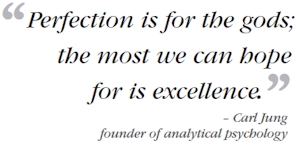The Dangers of Seeking Perfection
 Golf students come from all walks of life and personalities, each with their own motivations for playing the game. The one common thread that virtually all of these diverse individuals have is that they play the game for enjoyment. Even hardened competitors at the professional level are playing because they enjoy making a living in this manner.
Golf students come from all walks of life and personalities, each with their own motivations for playing the game. The one common thread that virtually all of these diverse individuals have is that they play the game for enjoyment. Even hardened competitors at the professional level are playing because they enjoy making a living in this manner.
Most of us recognize the fact that, as Dr. Bob Rotella said, golf is not a game of perfect, and we accept that we are not going to have “perfect” swings and will make a number of mistakes in a given round. However, there is a sizeable number of golfers who refuse to accept this, and they pursue the unattainable – perfection in golf.
It would seem such individuals should know that they are on a fool’s errand. However, the ideal of perfection resonates with these players, because they have experienced their definition of perfection many times. If it can be done most times, sometimes, or even once, they reason, why can’t it be done all the time?
Another side of perfectionism is in those who are seeking a “perfect” swing. They may accept that not every result will be perfect and that bad swings will still happen from time to time, but they believe a perfect swing can be attained.
For the ultimate in perfection, there are those who are seeking a perfect swing that can be executed perfectly each and every time. They are not willing to accept any mistakes, and they work very hard to eliminate both their swing “flaws” and less-thanperfect execution of the swing.
What causes such golfers to believe that perfection is attainable, and why do they pursue it so vigorously? The answer lies in the fact that some people believe they can attain anything if only they put their mind to it. They have achieved the nirvana of what they perceive as perfection in their own game from time to time, and so it’s only a matter of hard work to actually achieve it every time.
 It can be a good trait – seeking perfection – in the sense that it keeps a golfer motivated to improve, but it’s only good if that golfer realizes that working towards perfection and actually believing it’s attainable are two different things.
It can be a good trait – seeking perfection – in the sense that it keeps a golfer motivated to improve, but it’s only good if that golfer realizes that working towards perfection and actually believing it’s attainable are two different things.
Golfers who are close to “perfection” seem to be the most obsessed with it. Tiger Woods comes to mind on this. Brandel Chamblee from Golf Channel wrote an article detailing his belief that this is Woods’ mindset, evidenced in his changing swing coaches several times. An outside observer might ask, “Why didn’t Tiger just keep what he had under Butch Harmon or Hank Haney? After all, he was the best player in the world and perhaps the best anyone has ever seen.”
That’s probably not the way Woods saw it. He may have reasoned that he didn’t win every tournament, even in his prime, so there was room for improvement there. He also made many miscues when he won, so there was room for improvement there, too. Since he didn’t win every time or execute perfectly in victory, theoretically there would be room for improvement.
If you have students who are perfectionists, they may never be happy with where they’re at. They might constantly complain about their game and even your instruction. They may seek different teachers, looking for the one that will give them the magic potion that allows them to be perfect. The problem with changing teachers and/or swing philosophies is that after a certain point, the golfer will lose his or her natural feel for the game. They will lose what made them “them.” This might be what has happened to Tiger Woods, but it’s only speculation from the outside.
In dealing with perfectionist students, we can point out that no golfer in history has ever hit every fairway and green every time. Even the legendary Moe Norman and Ben Hogan, renowned as supposedly the only two golfers in history to truly “own” theirswings, missed plenty of fairways and greens in their prime. We can also try to get such students to realize that our bodies aren’t the exact same from day to day, or even from hour to hour. We’re not going to react or perceive things on the course exactly the same way all the time.
What they can do is make an effort on each shot to do their best at that time, whatever that may be. If they planned the shot properly, went through their pre-shot routine, and made the best swing they could, that’s all they can ask. This applies whether they are playing a round of golf or are on the lesson tee.
It’s fun to teach students who take our lessons to heart, work on their games, and strive to improve. Perfectionist students fall into that category, but hopefully we can get them to understand that their pursuit of perfection can be an asset if used properly, but extremely detrimental if not.




